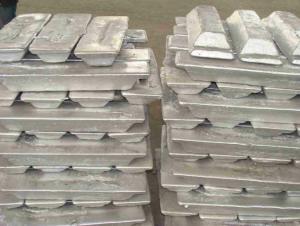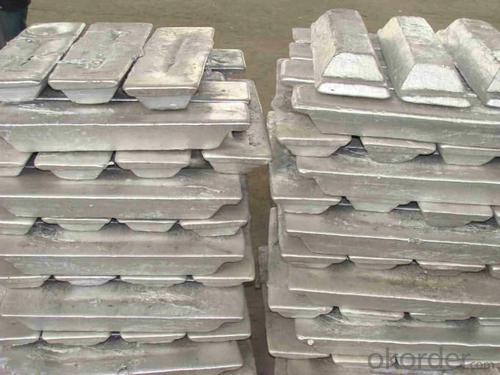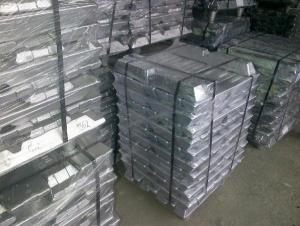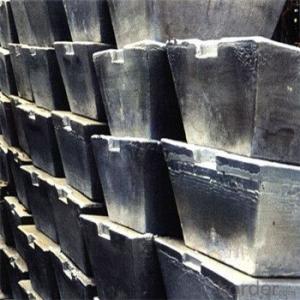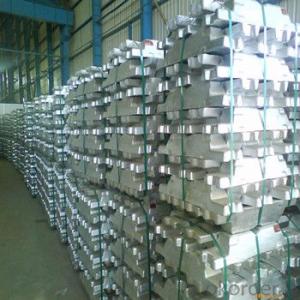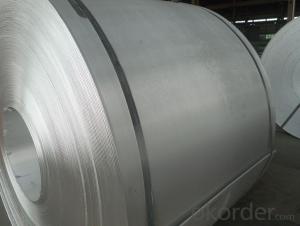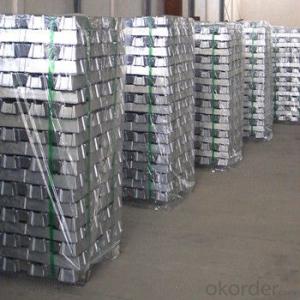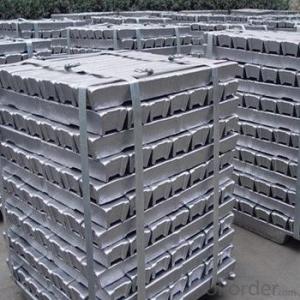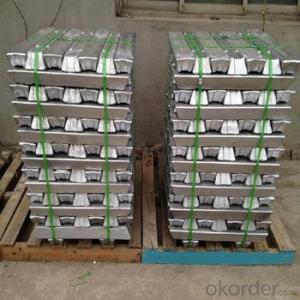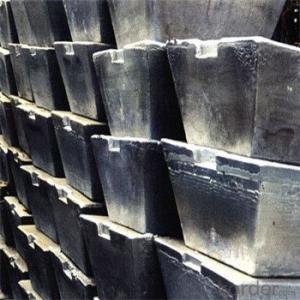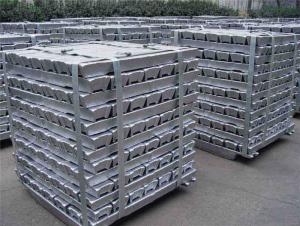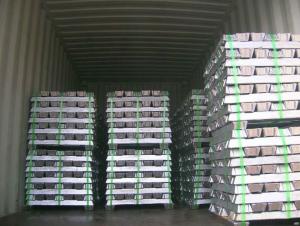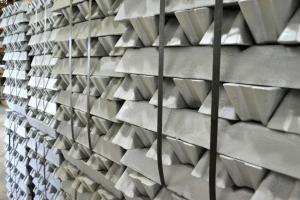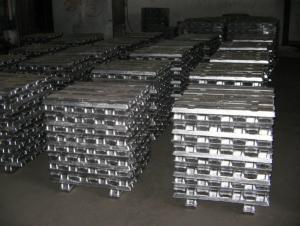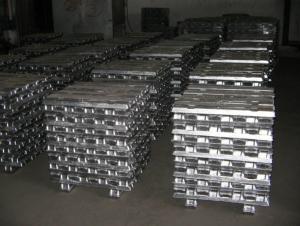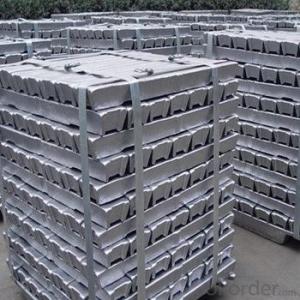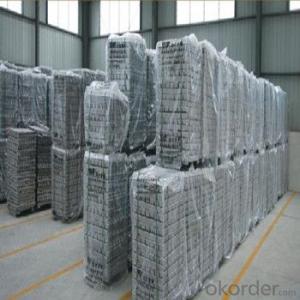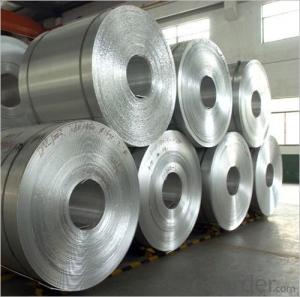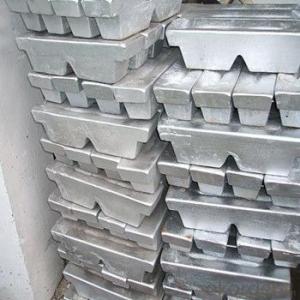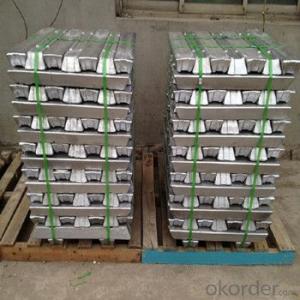Aluminum Ingots AA3105
- Loading Port:
- Shanghai
- Payment Terms:
- TT or LC
- Min Order Qty:
- 20 Tons m.t.
- Supply Capability:
- 1000 Sets Per Month m.t./month
OKorder Service Pledge
Quality Product, Order Online Tracking, Timely Delivery
OKorder Financial Service
Credit Rating, Credit Services, Credit Purchasing
You Might Also Like
1. Specifications of Aluminum Ingots AA3105
| Product Name | Aluminum Ingot |
| Chemical Composition | Al |
| Weight | 20/25kg |
| Al (Min) | 99%-99.9% |
| Appearance | silvery white |
| Advantages | easy control and operation, fast melting |
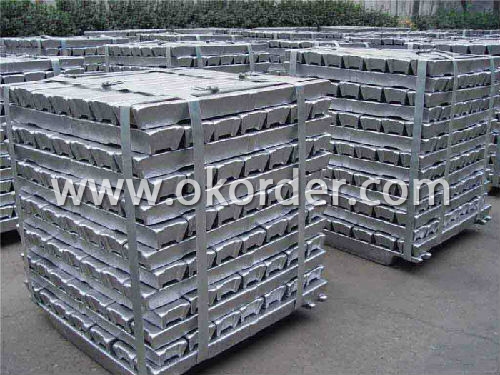
2. Usage/Application of Aluminum Ingots AA3105
A. mainly used for melting ingot
B. discontinuous melting with scrap
3.Packaging & Delivery of Aluminum Ingots AA3105
About 25Kg /Ingot, Packed in wooden case, Net weight 1000Kg/ Case, or as customer's requirements.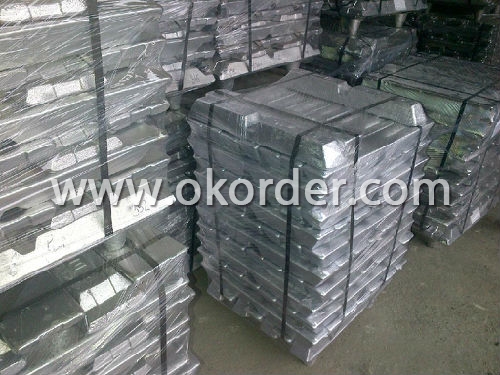
- Q: How are aluminum ingots used in the production of signage?
- Aluminum ingots play a crucial role in the production of signage due to their lightweight, durability, and versatility. When producing signage, aluminum ingots are melted down and then transformed into various sign components or sheets, depending on the desired design and purpose. One of the main uses of aluminum ingots in signage production is for creating sign frames. These frames provide structural support and stability to the signage, ensuring its longevity and resistance to weather conditions. The lightweight nature of aluminum makes it easier to transport, install, and maintain these sign frames. Additionally, aluminum ingots are often used to create sign panels or sheets. These panels can be cut, drilled, or shaped into various sizes and designs, allowing for customization and creativity in signage production. The durability of aluminum ensures that these panels can withstand outdoor exposure and remain intact for extended periods. Moreover, aluminum ingots are used to produce sign letters or logos. Signage made from aluminum letters provides a professional and sleek appearance that can enhance the overall aesthetic appeal of the signage. By using aluminum ingots, sign manufacturers can create precise and intricate lettering with ease. Furthermore, aluminum ingots offer excellent corrosion resistance, making them suitable for outdoor signage applications. They can withstand harsh weather conditions, UV exposure, and temperature variations without deteriorating or losing their visual appeal. This makes aluminum an ideal material for outdoor signs where durability and longevity are essential. In summary, aluminum ingots are widely used in the production of signage due to their lightweight, durability, and versatility. They are transformed into sign frames, panels, and letters, providing structural support, customization options, and a professional appearance. With their corrosion resistance, aluminum ingots ensure that signage remains intact and visually appealing even in challenging outdoor environments.
- Q: How much is the price of the common aluminum sheet on the basis of the aluminum ingot? How much is the price of the broken aluminum alloy profile on the basis of the aluminum ingot?
- Different regions, different prices, different agents, different prices, different surface treatment methods, different prices, different manufacturers, different prices
- Q: What is the role of aluminum ingots in the production of foils?
- Aluminum ingots play a crucial role in the production of foils. Foils are thin, flexible sheets made primarily from aluminum, which is known for its lightweight, strength, and corrosion-resistant properties. Aluminum ingots serve as the raw material for the manufacturing of foils. The process of producing foils begins with the melting of aluminum ingots. The ingots are heated to a high temperature, causing them to melt and transform into a liquid state. This liquid aluminum is then cast into thin slabs, which are subsequently rolled and reduced in thickness through a series of rolling mills. The aluminum ingots provide the necessary material for this rolling process. They are fed into the rolling mills, where they undergo continuous compression and elongation, transforming them into thin sheets with uniform thickness. The ingots act as the source of aluminum, ensuring a consistent supply of material throughout the rolling process. Aluminum ingots also determine the quality and characteristics of the resulting foils. The composition and purity of the ingots have a direct impact on the final product. High-quality ingots with low levels of impurities result in foils with excellent surface finish, superior strength, and enhanced resistance to corrosion. Furthermore, the size and dimensions of the aluminum ingots influence the size and dimensions of the foils produced. Larger ingots can yield wider and longer foils, while smaller ingots are suitable for narrower and shorter foils. In conclusion, aluminum ingots serve as the starting point and primary material for the production of foils. They are melted, cast, and rolled into thin sheets, providing the necessary aluminum for the manufacturing process. The quality, purity, and size of the ingots directly impact the quality and characteristics of the resulting foils, making them a critical component in the foil production industry.
- Q: What is the process for smelting aluminum ingots?
- The process for smelting aluminum ingots involves several steps. First, bauxite ore, which is the primary source of aluminum, is mined and refined to remove impurities. The refined bauxite is then transformed into alumina through a process called the Bayer process. Next, the alumina is mixed with cryolite and other additives in a large electric furnace. This mixture is heated to extremely high temperatures, reaching around 1,800 degrees Celsius. The intense heat causes the alumina to melt and separate into aluminum and oxygen. The molten aluminum is then tapped from the furnace and transferred to a holding furnace or a ladle. During this stage, the aluminum is often alloyed with other metals to enhance its properties. Common alloying elements include magnesium, silicon, copper, and zinc. Once the desired alloy composition is achieved, the molten aluminum is poured into molds to form ingots. These molds are typically made of steel and can vary in size and shape depending on the specific requirements. After the aluminum has solidified and cooled, the ingots are removed from the molds and undergo further processing, such as heat treatment or rolling, to achieve the desired mechanical properties and shape. Overall, the process of smelting aluminum ingots involves mining and refining bauxite, transforming it into alumina, melting the alumina to separate aluminum and oxygen, alloying the molten aluminum, pouring it into molds, and finally processing the solidified ingots to achieve the desired properties.
- Q: What type of spectrometer is used to analyze aluminium ingots?
- If it is an ordinary aluminum ingot, two or three 9, with direct reading spectrometer can be done. It is better to choose the imported equipment with stability and repeatability.
- Q: What are the advantages of using aluminum ingots in the production of renewable energy systems?
- One of the advantages of using aluminum ingots in the production of renewable energy systems is their lightweight nature. Aluminum is a lightweight metal, which makes it easier to handle and transport during the manufacturing process. Additionally, aluminum is highly durable and resistant to corrosion, making it suitable for outdoor applications in renewable energy systems. Furthermore, aluminum is an abundant and recyclable material, contributing to the sustainability aspect of renewable energy production.
- Q: How much is a ton of aluminium ingots now?
- Futures: the Fed announced interest rate hike, the dollar frustrated, overnight aluminum rose $23 to $1884 / ton; Shanghai aluminum night plate affected by the outer disk, the strong side of the shock operation;
- Q: How are aluminum ingots used in the production of doors and windows?
- Due to their inherent properties and versatility, aluminum ingots play a crucial role in the production of doors and windows. The first step involves melting down these ingots to create molten aluminum, which is then used to manufacture various door and window components. One primary application of aluminum ingots lies in the extrusion process. This process entails forcing the molten aluminum through a specially designed die to create continuous profiles of different shapes and sizes. These profiles serve as the foundation for door and window frames, sashes, mullions, and other structural elements. The extrusion process allows for tremendous design flexibility, enabling manufacturers to produce intricate and lightweight profiles that meet specific requirements. Furthermore, aluminum ingots are also employed in fabricating hardware components, including handles, locks, hinges, and fasteners. These parts are essential for the proper functioning and security of doors and windows. Aluminum's lightweight yet durable nature makes it the preferred choice for such hardware, as it offers strength without adding unnecessary weight to the final product. Additionally, aluminum ingots find use in the production of door and window panels. These panels can be crafted from aluminum sheets, which are formed, cut, and assembled to achieve the desired design. Aluminum panels deliver excellent thermal and sound insulation properties, making them energy-efficient and capable of reducing external noise. The utilization of aluminum ingots in the production of doors and windows offers several advantages. Firstly, aluminum exhibits high resistance to corrosion, ensuring that the finished products maintain their appearance and functionality over time. Secondly, aluminum is a lightweight material, making the doors and windows easier to handle and install. Lastly, aluminum is a sustainable and recyclable material, aligning with the growing demand for environmentally friendly products. In conclusion, the extensive use of aluminum ingots in the production of doors and windows stems from its unique properties. From forming extruded profiles to manufacturing hardware components and panels, aluminum serves as an ideal material for creating durable, lightweight, and aesthetically pleasing products.
- Q: What is the purity level of aluminum in an ingot?
- The purity level of aluminum in an ingot can vary depending on the specific manufacturing process and the intended application. Generally, aluminum ingots are produced with a purity level of 99.7% to 99.9%. This means that the ingot is composed of at least 99.7% to 99.9% pure aluminum, with the remaining percentage being made up of impurities and trace elements. Achieving higher levels of purity, such as 99.99% or even 99.999%, is possible through additional refining processes like electrolysis. The desired purity level is determined by the specific industry or application in which the aluminum will be used, as certain industries may require higher levels of purity for optimal performance and quality.
- Q: What are the challenges in sourcing sustainable aluminum ingots?
- One of the challenges in sourcing sustainable aluminum ingots is ensuring a transparent and traceable supply chain. It can be difficult to verify the sustainability claims made by suppliers and ensure that they are adhering to environmentally-friendly practices throughout the production process. Additionally, there may be limited availability of sustainable aluminum ingots, as the demand for such products may exceed the current supply. Finally, the cost of sourcing sustainable aluminum ingots can be higher compared to conventional options, which can pose a financial challenge for businesses.
We are a well-known enterprise specializing in the production and sales of aluminum sheets and coils.
Since the establishment of us, we have been devoted to setting up a good CIS and completely implementing ISO9001 quality management system.
1. Manufacturer Overview
| Location | Henan,China |
| Year Established | 1993 |
| Annual Output Value | Above US$200 Million |
| Main Markets | Mid East;Eastern Europe;North America |
| Company Certifications | ISO 9001:2000;ISO 14001:2004;OHSAS 18001 |
2. Manufacturer Certificates
| a) Certification Name | |
| Range | |
| Reference | |
| Validity Period |
3. Manufacturer Capability
| a) Trade Capacity | |
| Nearest Port | Shanghai |
| Export Percentage | 30%-50% |
| No.of Employees in Trade Department | 21-50 People |
| Language Spoken: | English;Chinese |
| b) Factory Information | |
| Factory Size: | Above 100,000 square meters |
| No. of Production Lines | Above 10 |
| Contract Manufacturing | OEM Service Offered;Design Service Offered |
| Product Price Range | Average |
Send your message to us
Aluminum Ingots AA3105
- Loading Port:
- Shanghai
- Payment Terms:
- TT or LC
- Min Order Qty:
- 20 Tons m.t.
- Supply Capability:
- 1000 Sets Per Month m.t./month
OKorder Service Pledge
Quality Product, Order Online Tracking, Timely Delivery
OKorder Financial Service
Credit Rating, Credit Services, Credit Purchasing
Similar products
Hot products
Hot Searches
Related keywords
